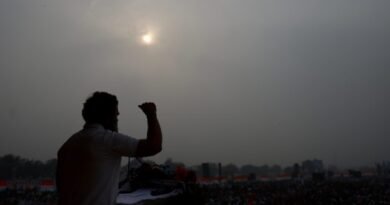Netaji and the Raj
Writers like Kalyan Kumar De and several other historians deserve all our gratitude to have brought before us certain hidden facts and constructed half-truths
A recently published book by the Netaji Subhash Bose INA Trust and released by Vice President Venkaiah Naidu on the eve of India’s 74th independence day provides a fresh perspective to the events leading up to the British Government’s decision to quit India in August 1947.
The British Raj, which was cruising along majestically for 200 years, suddenly developed serious doubts about its ability to rule the sub-continent in 1946 and hurriedly began the process of packing up. What hastened its exit from India? The book, Netaji — India’s Independence and British Archives, authored by Kalyan Kumar De, has put together several key reports and documents which throw light on the sudden change of mood in the British camp. These reports, primarily from the Governors of the various provinces and from the Intelligence Bureau (IB), indicate that by the mid-1940s, the British got into a panic mode because of the tremendous popularity of Subhas Chandra Bose and the nationwide appreciation and sympathy for the Indian National Army (INA), which he had established to militarily oust the colonial power. This, in turn, triggered a Naval mutiny in Bombay (now Mumbai) and several other stations and rebellions in some Army camps, including in Madras (now Chennai) and Poona (now Pune).
Historians have often wondered as to what brought about a sudden change in the mood in the British camp. The answer to this question was not easily available in the decades after independence for two reasons. The first is that the archival material was not available. The second reason is that since the 1950s, the Congress made every effort to downplay the popularity of Netaji and the INA. If it had come into the public domain that the British chose to hastily wind up operations for fear of a mutiny within the Indian Army and a general revolt among the masses, it would have spoiled the narrative vis-à-vis the non-violent struggle to gain independence. This process of suppressio veri (suppressing truth), which began in the days of former Prime Minister Jawaharlal Nehru, was carried on by the Nehru-Gandhis — Indira Gandhi and Rajiv Gandhi — because it suited the “history” the family wanted to popularise.
Subhas Chandra Bose’s determination, stamina and vision can be gauged from the fact that thousands of men and women responded to his call, joined the INA in India and in the South-east Asian countries and sacrificed their lives in order to liberate the country. In his book, De reproduces an IB report of November 1945, which warns the British Government that there was enormous sympathy for the soldiers of the INA across the land and that this was not just confined to the cities. It said that if the Government did not take cognisance of this sentiment, the consequence would be a mass agitation and bloodshed.
Going by the fear and anxiety displayed by several Governors in their reports to the then Viceroy, Lord Wavell in late 1945 and early 1946, the latter had little choice but to begin winding up operations. The Governors — one more worried than the other — expressed their trepidation at the ongoing INA trials and their repercussions. Almost every Governor warned the Viceroy that the Government would be playing with fire if it targetted the INA because it was seen as an organisation of brave freedom fighters. They warned that this could result in a mutiny in the Indian Army and they were not very much off the mark.
The Viceroy, in turn, kept King George-VI informed of the growing popularity of the INA and the mass protests it was generating in Calcutta and elsewhere. He said there was growing interest in the INA trials and it was bound to have political implications. In February 1946, he wrote to the then Prime Minister, Clement Attlee, and gave him an update on the naval mutiny in Bombay and other stations. He said it was now under control but the rioting by the mobs was still on in Bombay.
These fears forced the British to commute the sentences of deportation for life given in the court-martial to the most prominent three INA soldiers on trial — Prem Kumar Sehgal, Shah Nawaz Khan and Gurbaksh Singh Dhillon.
This is corroborated by General CJ Auchinleck’s “strictly personal and secret” letter to the Army Commanders on February 12, 1946, in which he talks about the reasons that prompted him to commute the sentences of deportation for the life of Sehgal, Dhillon and Khan. He says, confirmation of the sentences would have led to violent internal conflict. There was a “genuine feeling that they were patriots and nationalists” and, therefore, even if they were misled, “they should be treated with clemency as true sons of India.”
Officers in the Indian Army, he said, were glad and relieved at the final outcome because if the sentence had been enforced, “it would have led to chaos in the country and probably to mutiny and dissension in the Army…” Along with this, the Naval mutiny and the mutiny in the Army camps in Jabalpur, Madras and Poona convinced the British that they could no longer rely on the Indian armed forces to keep the British flag flying on the sub-continent. Once this realisation dawned on them, action was swift. The British Government took a formal decision to end the colonisation of India in March 1946.
Sir Twynam, Governor, Central Provinces and Berar, wrote a secret letter to Lord Wavell on November 26, 1945, in which he confessed that he had just 17 European officers, including three judicial, and 19 European members of the Indian Police (total 36) to manage a population of 18 million over an area of one lakh square miles.
These figures, given by Sir Twynam, indeed sums up the tragedy of India’s colonisation by the British. At the best of times, it is said that there were just a few thousand Europeans in the bureaucracy, police and Army and they had colonised a nation of India’s size with a population of about 400 million people.
Every Indian today will be stunned by these figures. How did millions of Indians allow themselves to be subjugated by a handful of Europeans? Lack of unity and self-confidence were certainly two factors that led to this dreadful tale of colonisation.
The work of De should also make us reflect over the work of other historians over the last 70 years who diligently practised suppressio veri and kept so many truths away from the people. We must re-examine all that they have written and challenge the postulates constructed on half-truths. Many individuals have worked for several years to dredge up hidden facts, including Kalyan Kumar De. All of them deserve our gratitude for enabling us to get closer to the truth.
(The writer is an author specialising in democracy studies. Views expressed are personal.)
Source: The Pioneer




